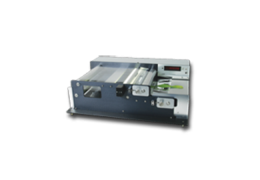Troubleshooting
The sections below define several potential problems and lists several possible causes and their solutions.
Continuous spurious data accumulation
- Lens cover has not been removed from the camera. Remove lens cover.
- Camera is at the wrong location. Check the actual camera position as described in Changing measurement resolution.
- Fluorescent tube not illuminated. Press "lamp start" switch and hold for 2 or more seconds.
- Fluorescent tube is cold. Wait until it warms up.
- Possible debris within the fluorescent tube. Remove the tube and perform the procedure in Voltage selector operation and characteristics. Alternatively, tip the instrument to about 45° by raising the front end to slide the debris to the end of the tube.
- Low line voltage. Check it and provide proper voltage to the instrument.
- Belts are excessively dirty. Clean belts (Cleaning the transparent belts).
- Mirror, camera, or detector (reticon) need cleaning. Clean according Cleaning the transparent belts and following sections.
- Obstruction in the optical pathway. Inspect the pathway and remove the obstruction.
- Calibration screw adjusted to be excessively sensitive. Note the original position of the screw and turn the screw counterclockwise until the displayed numbers remain constant. Return to the original position. Perform calibration as described in Calibration. If counts continue at an unacceptable rate, contact LI-COR.
Belts not tracking properly
If a transparent belt travels to one side of the pulley during operation, then the sliding pulley bearing blocks must be adjusted. Tighten the side toward which the belt is moving.
Fluorescent tube fails to illuminate
- Not properly twisted into the connector. Twist into the connector (see Instrument activation).
- Front tube power connector is not mated. Mate the connector (see Figure 7‑1).
Excessive data variability
- If samples are small or finely detailed, be sure to use 0.1 mm2 resolution.
- Improper camera location. See Changing measurement resolution and check against the actual camera position.
- Intermittent obstruction causes spurious counting. See Continuous spurious data accumulation.
- Portions of the sample protrude beyond the sensitive zone as defined by the sample guides. Be sure that samples remain within the sensitive zone.
- Static electricity may be causing movement of dry samples. Wipe the belts with a damp cloth. Enclose the samples in a transparent sheath.
- Samples are not pressed adequately by the upper belt. Enclose samples in a transparent sheath. See Pressing roller adjustment.
- Low ambient temperature. Readings should stabilize within 1-2 minutes of instrument activation.
- The lens must be rotated to the entire extent of the screw threads. Attempt further rotation to insure proper mounting.
- A loose lower belt may not support the sample at the correct position. Check to see that the lower belt contacts the lower idler but does not sag on both sides of the idler.
- If the instrument is operated with the rear cover removed, an intense stray light beam may focus on the reticon sensor. In order for this to occur, an unlikely series of reflections must occur after light enters through some location on the camera housing.
Miscellaneous malfunctions
Various types of problems occur if any of the connectors throughout the instrument lose contact. Inspect the connectors and press them together for better contact if necessary. Avoid reverse installation of connectors. Pin #1 is marked for installation into socket #1 of each connector.
Note that there is a 'Lamp Test' function on the display board that can be activated by connecting the two pins together momentarily.
Laboratory conditions
Do not allow exposure to corrosive vapor. Many laboratory procedures cause excessive corrosive vapor concentrations as indicated by corroded connectors and other visible parts on many instruments in such laboratories. Malfunction due to such corrosion is not covered by warranty.
In conditions of very high electrical noise on the AC Mains power circuit, or improper chassis grounding (the 3rd terminal of the power cord), the auxiliary computer display and the LI-3100C display may differ by a small amount, for less than the basic accuracy.
